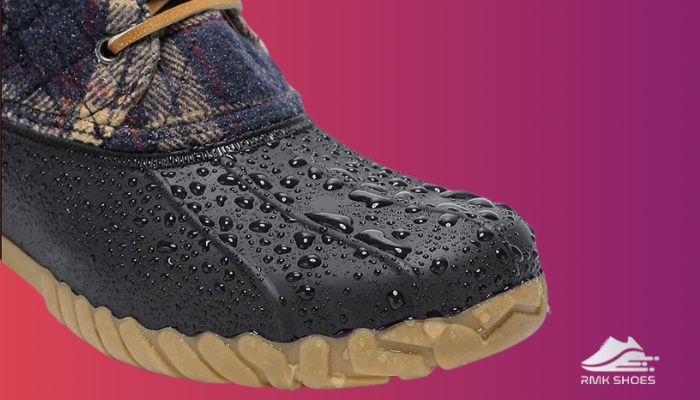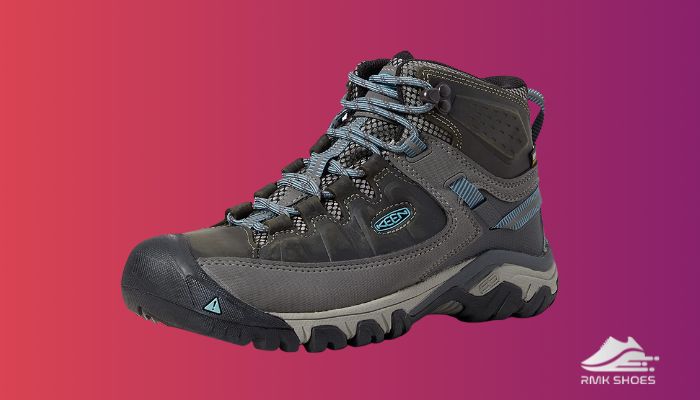After seeing the rubber outsole and sturdy appearance of duck boots, you might wanna grab a pair for your next trekking destination.

But before packing them up, you should know whether they actually good for hiking or not.
Being a regular user of duck boots, I’m aware of all the distinct factors about hiking in these boots. And here. I’m gonna describe the facts in detail.
So, let’s dive in!
Are Duck Boots Good for Hiking?
No, duck boots are not good for intense hiking. However, you can still wear them on short & easy hikes. You can not use duck boots on a rough trek due to their lack of breathability, lower traction, lack of ankle support, and improper fittings.
Duck boots are specially designed for hunting with rubber and leather. They offer dry and warm feet on wet and muddy surfaces. Moreover, the duck boots include ankle and mid-calf which provide cozy warm feelings in the snow.
Unfortunately, these features make buck boots improper for long hiking because during the hike we need extra breathability and traction.
Not only for breathability, but we also need snugly fitted shoes for trekking, where duck boots tend to be loose.
Follow our guide on how to tie Duck Boots.
Factors That Make Duck Boots Suitable For Short Hike
If you don’t have other shoe options and wish to complete any short trek program in a muddy area, you can consider your duck boots for your hiking trip. In this pair, you will find four factors that can smoothen your trekking journey.
So, let’s know the behind factors that make duck boots suitable for short hikes:
Comfortability
Duck boots are more comfortable compared to other hiking boots. The Innersole of this boot is not rigid like designed trekking shoes. That’s the main reason people love to wear them on short terrain and long walk.
Moreover, these boots are properly sealed from outer elements so, you can find a secure and dry space for your feet. They also offered extra insulation, which is helpful on cold snowy days.
Easy to Maintain
If you love to explore, then you better know about the difficulty of cleaning rugged hiking shoes. The mud and grime are not so easy to clean up from hard-to-reach crannies.
Contrary, duck boots are easy to clean of their smooth and even leather upper. Plus, the full-grain leather upper is not damaged easily after rapid cleaning.
Not only that cleaning facility but duck boots are also easy to put on which is more convenient for me.
Waterproof
The most attractive factor in duck boots is their waterproofing feature. Because of their waterproof attributes, you can wear them in any type of area from wet to cold. 
Can you ever imagine, crossing one runny terrain, but your feet are completely dry, how pleasant the situation is!
And first, I achieved this experience with duck boots. So, if you think of a short trek in any sloppy area, duck boots are the best option.
Lightweight Feature
The most painful part of hiking shoes is their heavy weight.
Besides, specially designed hiking boots are bulky in nature and tough to carry in your bags when you are going for any short trip.
Luckily, duck boots are lightweight which doesn’t mean they are ideal for all trekking, but you can use them on your short trip. For its compact feature, you also can store them in your handy bags.
Check out our separate post to know are Duck Boots supposed to be loose.
5 Reasons That Make Duck Boots Unpleasant for Hike
As I have mentioned before, you only use your duck pair on a short stroll. To complete any long trekking, you should get ideal hiking shoes. Now, I’ll describe the reason that makes your duck boots unpleasant for an adventurous trip.
Let’s check out the reasons for the terrible experience of hiking with duck boots:
Lack of Breathability
Leather and rubber are splendid materials for waterproofing. At the same time, they create the most non-ventilated space for your feet. 
The materials are famous for their nature of keeping the humidity inside, which generates a suffocated situation and lack of breathability. The situation becomes worse when you cross rough terrain on a hot summer day and your feet sweat the most.
And finally, your feet may stink after absorbing all sweat.
Low Ankle Support
Ankle support is essential because hikers need good protection during a long hike. Because lower supportive shoes can cause severe ankle pain.
Duck Boots doesn’t offer as much ankle support as required in hiking shoes for easy movement on the uneven trekking path.
And when you opt for hiking with duck boots, the limited ankle support creates obstacles in your bending movement and invites several injuries.
Traction & Grip
Duck boots come with a lack of traction compared to other hiking shoes. During trekking, grip, and traction play a vital role when you walk on rough terrain.
These boots are good for snow, where you have to cross sloppy surfaces, but the offered traction is not sufficient for rocky grounds.
Spacious Inner Space
Generally, duck boots are supposed to be loose and offer spacious inner space. And that extra inner capacity is not appropriate for hiking. Because the large space creates friction between the shoe and your feet.
Friction is the main reason for discomfort and blister in your long hike.
Where we demand snug fitting in hiking shoes, to cross the uneven and rocky grounds, the large space of duck boots creates difficulties.
It increases the chances of injury when your leg continuously moves in the shoe inside. Plus, the slippery tendency decreases the traction ability, which is essential to cross rough terrain.
Expensive
Duck boots ask a huge amount per shoe for their exclusive materials, whereas most hiking shoes charge a minimum.
Many of us, use one shoe for one trek because, after that hazardous terrain, the shoes are not surviving more. Due to the higher price of duck boots, you can not throw them after one use.
These are the main 5 reasons that I found in my traveling time. In one word, if you want to wear your duck pair in the terrain it will offer more difficulties over pleasure, so try not to use them on long hiking.
When You Choose Your Duck Boots for Hiking?
Apart from all the ups and downs of strolling in duck boots,
Take a look at where you can use your duck boots for hiking:
In a Short Hike
You only use your duck pair as hiking shoes in short trekking, where you only wish to hike for less than 2 hours. Because breathability and ankle support are crucial to prevent blisters and injuries which are missing in duck boots.
On the Snow
Duck boots are essential for chilly weather to keep our feet dry and healthy. So, if your destination hiking place is a snowdrift or marshy area, you can blindly rely on your duck boots.
On top of that, duck shoes also offer better traction on the snow along with a warm feel.
In the Wet Terrain
Duck boots are specially designed for hunting in wet and muddy areas. So, they have all the features that make them ideal for hiking on wetlands.
Their micro-fleece lining sealed all entrances. So that, the outer element and moisture couldn’t come inside the shoes. Plus, duck boots offer all the comfort that you need in wet terrain.
Additionally, duck boots are a great substitute for rain boots, because of their exceptional features.
Bottom Line
After all the detailed discussion of hiking in duck boots, now you know the pros and cons of them.
I hope this article will help you to take the right decision about where you can trek in your duck boots and where you can’t. If you ever experience any hike with your duck boots, share that through the comment.
Up to then, Happy hiking!




